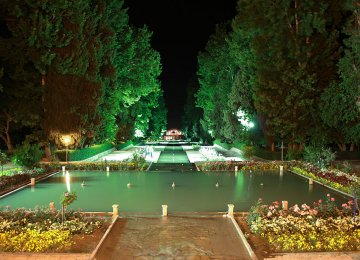The Persian garden or Pairidaeza (a hostile paradise), was filled with exotic plants and animals. It had watercourses round the perimeter, as well as within to divide the garden into compartments. The trees and other plants grew in beds sunken below walkways and were irrigated by periodic flooding. This was to become the paradigm for all later Pairidaezas.
The original desert garden is primarily an enclosed, shaded garden of fruit trees, (but with few other flowers), its elements including water, plants and pavilions; a sacred trilogy that combine to generate beauty and spiritual quality. The enclosing wall serves to keep out dust and heat and to hold moisture within to create a microclimate essential to plant life in the garden. The source of water, be it a spring or a qanat (an artificially constructed underground water channel), provides the element of life.
The buildings are sanctuary for the travelers. The dichotomy between inner and outer space separates the material world from the spiritual. Upon entry, the body of water divides into two parts. The main body forms the primary axis of the garden, which runs the whole length; the rest is fed into lateral channels that encompass the garden and merge with the first shortly before exiting it. The water in the main axis at a point is met by a tank from where two channels lead off to the sides to join the lateral rills, thus forming a four-fold plan or 'Chahar Bagh' (although this term was not actually used until at least in the 10th century AD).
Immediately behind the cross-axis sits the 'Kushk', or pavilion, which has formed the focal point of the Persian Garden since Sassanian times. Additional buildings such as baths, kitchens, and servants' quarters are added as required in the fringes of the garden.
The garden is usually entered through a portal entrance opposite the central axis. The garden may be in a flat area or on a slope. Gardens occurring in flat ground normally have the cross-axes of water in the middle of the garden. However in sloped settings, the garden will have a longitudinally tripartite plan, that is, the cross-axes will occur one-third of the way down the garden to offer a greater view of the garden in the foreground. Here, water ripples over carved screens (shadravan) generating a murmuring sound.
Rows of trees are planted on both sides of the principal axis leading to the pavilion and beyond, with traverse walks between the trees and the rill. There are fountains at short intervals in the waterway, shooting high the air by gravity, cooling the air and discouraging insects. The lateral axes are also flanked by shade trees, to give protection not only from intense sunlight but also from wind, dust and heat.
The trees are of many sorts to form the quintessence of the garden. Structural trees which serve to outline the garden and fruit trees which are massed in compartments for sustenance as well as beauty, wind breakers, ornamental varieties and garden cultivars are commonplace in Persian Garden. The Chahar Bagh appears as a major motif on Persian carpets and rugs.
Nine Persian Gardens UNESCO world heritage list:
Pasargad paradise (both pavilion and tomb),
Eram garden in Shiraz,
Pahlavanpour Garden in Yazd,
Dowlat Abad Garden in Yazd,
Chehel Sotoun Garden in Isfahan,
Abbas Abad Garden in Behshahr, Mazandaran Province,
Akbariye Garden in Birjand, south Khorassan Province,
Shazde Garden in Mahan, Kerman Province,
Fin Garden in Kashan.





